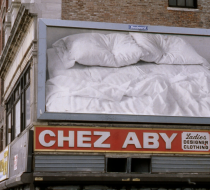Untitled Favorite
In May 1992, a series of 24 billboards displaying an identical image began appearing throughout New York City. They featured a giant close-up black-and-white photograph, without text, of a rumpled bed, pillows still indented from the heads that had rested there. The image had been captured by the Cuban-born American artist Felix Gonzalez-Torres, whose partner, a Canadian sommelier named Ross Laycock, had died the year before from complications of AIDS; the number of billboards correlated to the date Laycock died in January. The harrowing portrait of loss, which, like many of the artist’s works, was labeled “Untitled,” occupied the liminal, often uncomfortable space between art and advertising. Made a few years before the peak of the epidemic in the United States, it brought the domestic devastation of AIDS into the public realm, where, at the time, such realities were largely met with silence and denial. The piece’s simplicity remains its power: Gonzalez-Torres, who, four years later, succumbed to effects of the disease at age 38, forced us to confront not merely the millions taken by the virus, but the incalculable sorrow of those left behind. — N.H.
SN: I’m currently in New Mexico working on a feature-length film called “Land of Dreams,” which is about looking at America from the point of view of an immigrant and Iranian woman artist. It gives a very diverse sociological reading of the country. This character goes door to door to people’s houses and questions them, and asks them about their dreams and nightmares — and in doing so, she addresses not just economic difference but what has happened with the communities of African-Americans and Native Americans. It’s a complicated narrative. So even though I’m working with fiction, it’s my way of being a political activist. This work is my first time daring to offer a point of view on this country, which is something I’ve never done before. So like Cathy said, everything that I make is political. I don’t even have the choice, because all the topics that I’m touching on have affected my life very directly. My work is the product of myself. That’s the most honest way I can make art. It’s not a gimmick and I’m not trying to be politically correct. It’s a really important step for me to embark on this project at this moment of American history as a Muslim Iranian immigrant. Whether it succeeds or not, I don’t know. But subconsciously, I think a lot of us are gravitating toward making work that is politically charged.






